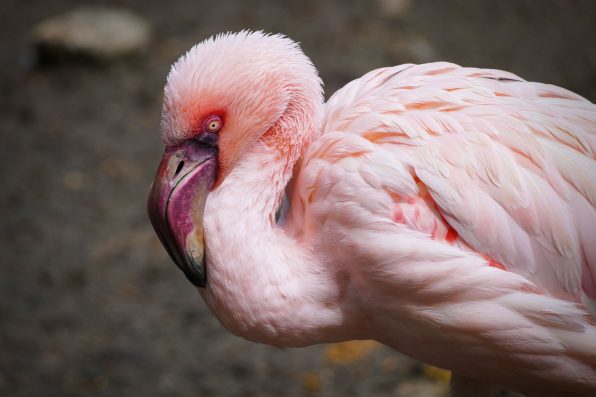A Pair Of Flamingo Foster Fathers At The San Diego Zoo Safari Park Hatched An Egg And Are Raising A Chick Together

At the San Diego Zoo Safari Park, a pair of flamingos have become parents for the first time after hatching an egg together. Surprisingly, both of the parents are dads.
The flamingo dads are both in their 40s, and they are raising one of six chicks born at the park this year. The park cares for almost 100 lesser flamingos. The species is characterized by their pink feathers and their long legs and necks.
Wildlife staff noticed the duo building a nest together one day. They are known as White 77 and White 26 due to the colored, numbered bands around their legs.
“They started paying a lot of attention to an empty nest mound, taking turns sitting on it, manicuring it. They built it up, just the two of them, but obviously weren’t laying an egg since it was two males,” said Erin Massey, a lead wildlife care specialist who has worked at the park for 27 years.
Pairings of two males or two females sometimes occur in animals in captivity and nature. Previously, a pair of female Chilean flamingos raised a chick together at the park after they both laid eggs.
Before that, a crowned crane couple consisting of two males fostered a chick together after they were given a fertile egg.
Since the two flamingos were displaying nesting behaviors, the staff decided to provide them with a fake egg to see what would happen. The aim was to determine if they would be good foster parents and to keep them out of the way of other flamingo couples that were caring for eggs.
“Once we gave them the fake egg, they were both showing a lot of interest,” Massey said. “They were very excited. They were talking to each other. They were standing over the egg. One of the males got onto the nest immediately and sat down right away.”
Over the next few weeks, the male flamingos behaved exactly like any other pair of nesting flamingos. They even took turns sitting on top of the nest.

PT Hamilton – stock.adobe.com – illustrative purposes only, not the actual flamingo
The staff took a fertile egg from one pair, hoping they would lay again. That egg was given to the foster dads. Their chick hatched three weeks later. It is not yet known if the chick is a male or female.
The chick was about the size of a tennis ball with fluffy gray feathers. Its feathers will stay gray for about a year until the pink feathers grow in.
During the chick’s early days, the dads monitored it closely. For the first five to six days, they took turns sitting on the chick to keep it warm and protect it from predators.
They both fed it “crop milk,” which comes from their upper digestive tract. Both males and females produce crop milk.
When the bird was old enough to leave the nest, the two dads followed behind as it wandered around. The chick is now about six weeks old and hangs out with other flamingos of its age.
In the future, the two dads may be tapped to be foster parents if they remain bonded. Using foster parents helps the Safari Park to produce as many healthy flamingo chicks as possible.
This is important because lesser flamingos are considered near threatened. They are native to sub-Saharan Africa and western India, but their numbers in the wild are declining. Their breeding areas are also in danger of disappearing.
“Historically, lesser flamingos have a really low fertility rate with their eggs. They’re very difficult to breed. So any fertile eggs and pairs who lay fertile eggs are incredibly valuable,” said Massey.
Sign up for Chip Chick’s newsletter and get stories like this delivered to your inbox.
More About:Animals





